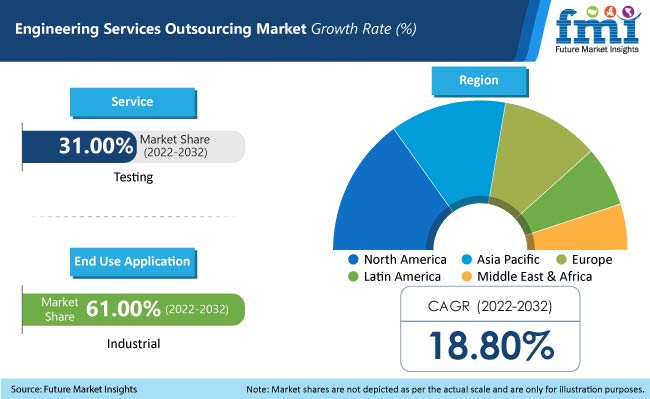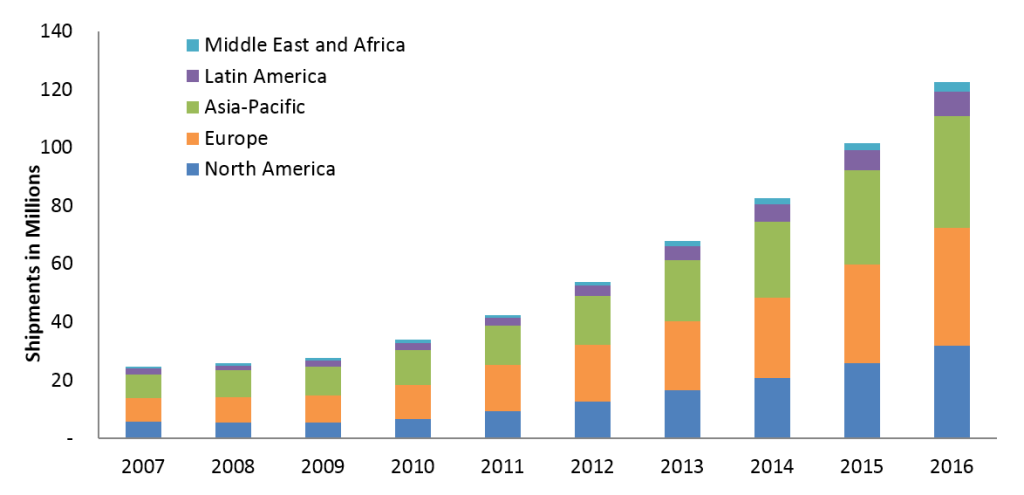AuthorSudip Saha - fmi  The global engineering services outsourcing market size is expected to be valued at US$ 949.7 Billion in 2022. With the increase in adoption of automation and integrated solutions for analysis, coupled with the introduction of cloud-based engineering software products, overall demand for Engineering Services Outsourcing is projected to grow at a CAGR of 18.9% between 2022 and 2032, totaling around US$ 5,362.7 Billion by 2032. Data Points Key Statistics:
Engineering services outsourcing refers to utilizing the best technology and services related to the business core engineering process such as auto designing, computer-aided manufacturing, and designing to get new-age engineering products with low cost and a competitive edge. Engineering services outsourcing has applications in industries such as aerospace, automotive, construction, consumer electronics, semiconductor, pharmaceuticals, and telecom and among others. One of the key drivers driving the adoption of engineering services outsourcing is likely to be the growing collaborations between original equipment manufacturers and engineering service providers. The globalization of research and development activities, increased demand for utilizing the advanced and latest technologies in product offerings and the growing need to shorten product lifecycles and minimize costs are all likely to drive the engineering services outsourcing market expansion. The engineering services outsourcing market has been steadily developing in response to customers’ increasing emphasis on outsourcing various services as part of their cost-cutting efforts. The major challenges in the global engineering service outsourcing market such as the lack of domain expertise among workers or companies, poor infrastructure development, and poor regulatory support are all expected to impede the growth of the Engineering Services Outsourcing Market over the analysis period. Read the rest of this article here: https://www.futuremarketinsights.com/reports/engineering-services-outsourcing-market
0 Comments
Introduction
No one would disagree that the impact of wireless and mobile communication in our daily lives have been profound, to say the least. One can confidently say that no technology has been adapted so rapidly in a global scale as the mobile telephony. It is noteworthy to mention that since the first deployment of AMPS systems in the US in 1983, the adoption of the technology has been growing exponentially in a global scale. Based on GSMA, over 3.89 billion people had subscription to mobile telephony in 2016. This number is expected to grow to 5.8 billion by 2020. While this number may look overwhelming, it is expected to be dwarfed compared to the anticipated number of the connections forecasted for IoT systems. McKinsey, for instance, puts the number of IoT connected device at 30 billion by the end of 2020. GSMA predicts a total contribution to the global economy of around $4.2 trillion in 2020. As the world becomes smaller and the “Internet of things” becomes larger, mobility and global services, i.e., provisioning, connection management, security, control and monitoring (roaming) of Machine to Machine (M2M) devices have become essential. For instance, many modules purchased and provisioned in one location/country need to operate in other countries.
The deployment dynamics of M2M modules and applications differ from traditional, high-end consumer and business subscribers using smart phones and laptops; operators now have to consider low ARPUs, adapted data plans, and permanent roaming solutions to stay competitive in the M2M market. In this article we will look at some of the opportunities and challenges facing this industry. |
By Jesse Khatam,
|
|
Based in San Diego, CA with program management and engineering teams in San Diego, CA and Hanoi Vietnam. Collaborative product development and program management for smart wireless and IoT devices using wireless technologies – 4G/5G, WiFi, GPS, BT/BLE, NFC, and RFID.
© COPYRIGHT 2022. ALL RIGHTS RESERVED. SITE TERMS
|
ABOUT |
CONTACTNexus Engineering Solutions
16885 W. Bernardo Drive, Suite 272 San Diego, CA 92127 +1 (858) 432-3256 Send Us An Email |

 RSS Feed
RSS Feed 
